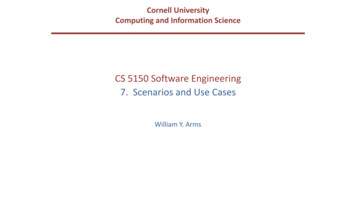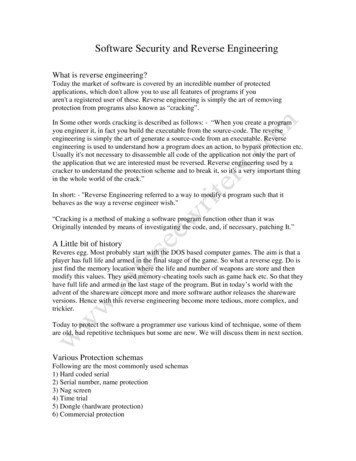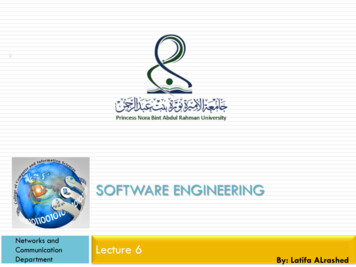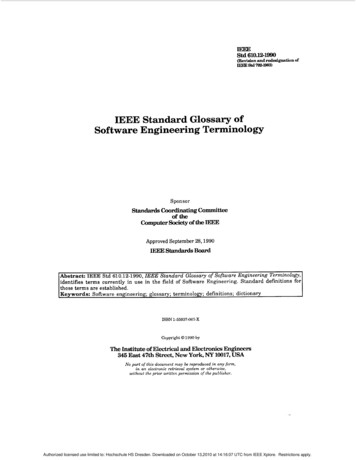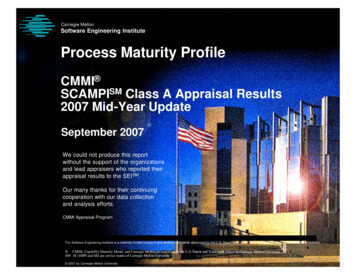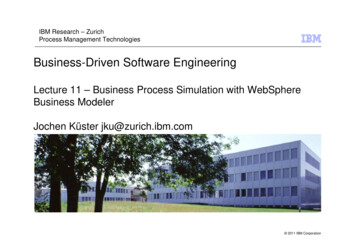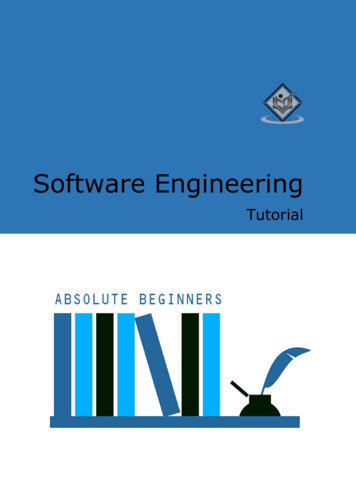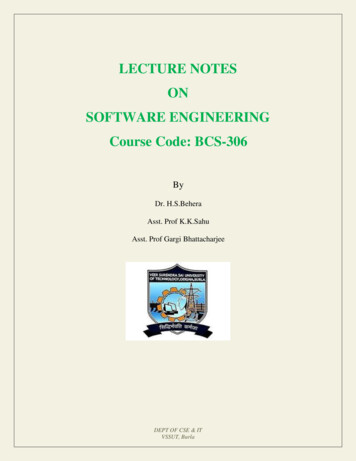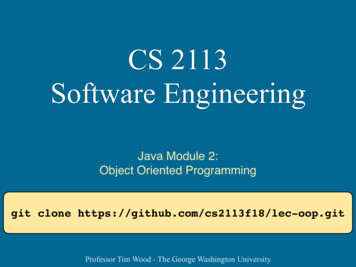
Transcription
CS 2113Software EngineeringJava Module 2:Object Oriented Programminggit clone https://github.com/cs2113f18/lec-oop.gitProfessor Tim Wood - The George Washington UniversityProfessor Tim Wood - The George Washington University
Like Tacos? CS Research Isn't Scary: Friday, 5pm-7pm in SEH Lehman Auditorium/Green wall area 5pm is the panel, 6pm is a postering session with catering fromDistrict Taco!2
Last Time Moving from C to Java Basic syntax, object creation Project 1: Linked Lists How's it going? Start coding ASAP! Get help:8-10hour Piazza, email Prof. Wood: Wed 6-7pm or by appointment Office hours: check piazza pinned posts perweek!!3
Java Module 1 Your code goes in your README file Use proper markdown formatting! javaMarkdown syntax to start acode block with java syntaxhighlighting!public class Hello{// } !4
This Time Java Objects and Classes Objected oriented vs Procedural programming Access control Inheritance Basic UML Diagrams Representing code visually Class Diagrams!5
The Java docs The main documentation of the Java language is inthe form of "javadocs" Created from informative comments in the actual source code Java 10 w-summary.htmlPractice reading these!!6
Textbook Reading Read Chapters 4, 5, and 7 Objects and inheritance Do this before the next lab!!7
Procedural vs Object Oriented Programming is about functions and data In C (a procedural language) those were kept separate:struct employee {char* name;double salary;};double getTaxRate(struct employee* e) {.} Procedural programming focuses on whatneeds to be done Object oriented programming focuses on thedata that must be manipulated!8
Nouns vs Verbs Procedural is about actions (verbs) O.O. is about things (nouns) A simple program:Write a program that asks for a number andthen prints its square root. A more realistic example:A voice mail system records calls to multiplemailboxes. The system records each message,the caller's number, and the time of the call.The owner of a mailbox can play back savedmessages.!9
Benefits of O.O.P. Focuses on Data and Relationships Break functionality of program down intointeracting objects Divide and conquer Clearly defined interfaces between components Fewer bugs from unexpected interactions Ask an object to modify itself Supports hierarchies of objects!10
Objects and Classes in Java In Java:public class Hello {public static void main (){System.out.println("hi.");}} A class is type of object All objects have a class Primitives (int, float, etc) and functions are not objects Classes contain data and functions An object instantiates that data Class Constructor Used to create new objects Initialize variables Must call super(.) ifa subclasspublic class Car {public int x;public int y;public Car(int x, int y) {this.x x;this.y y;}public void setX(int x) {this.x x;}!11
Creating new Objects To use an object we need a reference to it Use the new command to instantiate an object Reserves memory on the Heap for that object class Each new object gets its own chunk of memory But they share functionsand static class variablesStackpublic static void main(.){Car chevy;Car honda;honda new Car(10, 04y20!12
Racing Get the code and run it (press ctrl-c to quit):cd lec-oop/procjavac SimpleTrack.javajava SimpleTrack Simple changes Green car Different car symbol Faster car Harder changes: Have two cars instead of one (Don't add any new classes yet)!13
static Members static Functions and Data are not specific toany one object instance One copy is kept for the entire class You can access static members with just theclass name Do not need a reference to a specific object Useful for globally available data or functionsthat do not depend on any one object instanceClassnameObjectnameMath.random() // static method in Math classMath.PI // static data object in Math classCar myCar new Car(10,10);myCar.x // instance variable!14
Uses of static #1: Great for classes that cannot be instantiated: Math class Provides general utility methods, doesn't have any data that must beunique for each object instance. You never do "new Math()" #2: Useful for sharing a single variable for allinstances of a classpublic class Car carsBuilt counter Isn't unique to each car Shouldn't need areference to a car objectto find out how manyhave been made Just don't abuse it{public static int carsBuilt;public String license;public Car(){carsBuilt ;// .}}Car c new ntln(Car.carsBuilt);!15
Modularizing the code Terminal class: constants related to printing colors Car class: a "V" drawn to the screen that randomlymoves back and forth. Starts at random position. Data? Functions?Work in lec-6/oop RaceTrack class: instantiates a car object and hasthe main run loop of the programLoop forever.update the car's positionfor each horizontal position in the line.if the car is at that position, draw itelse draw an empty spaceprint newline character and reset the colorsleep for 30 milliseconds!16
Lots of objects How do we make an array of objects?Car cars[10];for(int i 0; i cars.length; i ) {cars[i].move();}!17
Lots of objects How do we make an array of objects?Car cars[] new Car[3];for(int i 0; i cars.length; i ) {cars[i] new Car();}for(Car c: cars) { // fancy array loopingc.move();} Note: We can’t use the fancy loop when allocatingthe cars why?!18
Lots of cars! Modify your program so it can create 3 cars atrandom positions and show them driving around Too easy? Try these: Each car can be a different color Make the left and right sides of the race track dynamically changewidth and don't let any cars go beyond them If two cars collide, they should explode (i.e., display X and stopprinting those two cars from then on) Make the program stop when only one car is left!19
Inheritance Classes can be defined in a hierarchy The child (subclass) inherits data andfunctionality from its parent (superclass) Use the extends keyword in javapublic class RocketCar extends Car {public int numEngines; // define new class memberspublic RocketCar(int x, int y, int n) {super(x,y); // must call parent's constructornumEngines n;}public void draw(){drawSmokeTrail();super.draw(); // optionally call parent version}}!20
Functions Inherited from parent class Can be replaced fully, or can call super.funcname() tocombine parent and child functionality Supports multiple declarations with differentparameterspublic void draw(Color c){// draw with specific color}public void draw(){// this code is unnecessarysuper.draw()}!21
Vehicle Types Extend your program to define multiple types ofvehicles or objects with inheritance Some options: Wild cars move more erratically than regular race carsSome cars look different from othersTrees only appear on some linesWalls are at the edges of the track and move less erratically thancars. If a car hits a wall it crashes .something more creative that you think of.Time check? 4:45!22
Limiting Visibility Goal of OOP: compartmentalize data andfunction Classes can be: public - visible everywhere (no keyword) - visible within package Data and functions can be: public - callable, readable/writable by anyoneprivate - only accessible within the same classprotected - accessible in the class, subclass, and package(no keyword) - accessible within the package!23
Visibility Answer question 1 on the worksheet. Data and functions can be: public - callable, readable/writable by anyoneprivate - only accessible within the same classprotected - accessible in the class, subclass, and package(no keyword) - accessible within the package!24
O.O. Design Modern software engineering is largely aboutdesigning classes, deciding how they relate, anddeciding their functions data Good design: is simple: remove unnecessary classes, functions, and data is compartmentalized: separate functionality, isolate data has clean interfaces: inputs and outputs should make sense is reusable: create general purpose code when possible!25
UML Unified Modeling Language Formal way to describe programs, components, functionality Designed for any object oriented programming language Defines 14 standard diagram types Structural diagrams Defines the piecesof the system andtheir relationships Behavioral diagrams Describe how the piecesinteract!26
Class Diagrams Tell us how different classes are related Lists key methods and data!27
Simplified Class Diagrams How are these related? Human, Student, Hand, Pen, and Pencil?HumanPenHandStudentPencil"is a""associated with"!28
Class Diagram ExampleClass diagrams describe the software'scomponents and how they relateHumanhas 2HandholdsownsPenWritingUtensilStudentPencil"is a""associated with"!29
Arrow Direction The arrow shows which class must knowsomething about the other A child must "know" about its parent so it canextend it The parent can be oblivious to that factHumanHand"associated with"Student"is a” (inherits from)!30
From Diagram to CodeHumanHandPenStudentWritingUtensilPencilpublic class Human {protected Hand leftHand;protected Hand rightHand;public class Studentextends Human{private WritingUtensil wu;public Human() {leftHand new Hand();rightHand new Hand();}public Student() {super();wu new Pen();rightHand new Hand(wu);}}}!31
Adding More Detail Full UML diagrams also include: Attributes (class data elements) Methods (class functions)HumanStudentname: Stringage: intleftHand: HandrightHand: Handschool: Stringmajor: Stringwalk()eat()sleep()study()goToClass()lists the dataand functionsadded to theparent class Also uses a whole bunch of arrow types!32
Voice Mail System Problem description:Phone rings, is not picked up, callerinvited to leave message; owner ofmailbox can later retrieve message Is that enough to build the system? Requirements Engineering Science behind formally specifying what a system must do!33
Deciding on the parts Things: MailboxesMessagesUsersPhone numbersDatesA voice mail system recordscalls to multiple mailboxes.The system records eachmessage, the caller's number,and the time of the call. Theowner of a mailbox can playback saved messages. Actions: Record messageReplay message.Remove messages?Next/Previous Message?!34
MailSystem Class Diagram What are the components? What are their important functions and data? How are they related? Annotate arrowsInherits fromWork with 1-2other studentsand draw yourdiagram on theworksheetMakes use of!35
MailSystem Class Diagram What are the components? What are their important functions and data? How are they related? Annotate arrowsInherits fromClient request: Wealso want to supporttext messages on thesame system!Makes use of!36
How do things interact? Class diagram tells who interacts with who But doesn't illustrate how they interact UML Sequence Diagrams Show the steps required to do something!37
Good Practices Diagram should be loosely connected Only make a class depend on another if it really needs it Use Inheritance to replace similar functionality Red balls, green balls, and orange squares Chickens, cows, and tanks Focus on key features and level of detail UML can be a waste of time, so apply to the useful parts Iterate design and implementation Don't try to do everything the first time Build and test components in stages!38
UML Tool Violet UML tool makes it easy to draw diagrams Homepage: http://alexdp.free.fr/violetumleditor/ Download from 2113 Java Module 2 page!choose mode:SelectClassInherits from.Is associated.double clickto edit!39
Banking Use VioletUML to represent the following programYou have been hired by a bank to write software to track its accounts andclients. Your bank software must keep track of two kinds of accounts: Checkingand Savings. Both these account types should support making deposits andwithdraws. The Checking account should also allow customers to write a checkand the Savings account should support adding interest.The bank needs to be able to keep track of all of its customers, each of whommay have one or more accounts. Every month, the bank needs to be able toprint out a list of customers and the balance inside each of their accounts. Youcan assume that all customers have a unique name and that bank accountsare assigned a unique ID number.Draw a UML diagram to represent the software you would design to handle thisscenario. Be sure to mark the important functions and data members for eachclass, and use the different arrow types to indicate which classes inherit or areassociated with others.!40
Summary Java emphasizes Object OrientedProgramming We use OOP to write better structured code A correct program is always better than a fast buggy one Think about how you organize classes Use private variables and expose clean interfaces Use inheritance to reuse code UML can help plan your code!41
Full UML diagrams also include: Attributes (class data elements) Methods (class functions) Also uses a whole bunch of arrow types!32 Human name: String age: int leftHand: Hand rightHand: Hand walk() eat() sleep() Student school: String major: String study() goToClass() lists the data and functions added to the parent class

